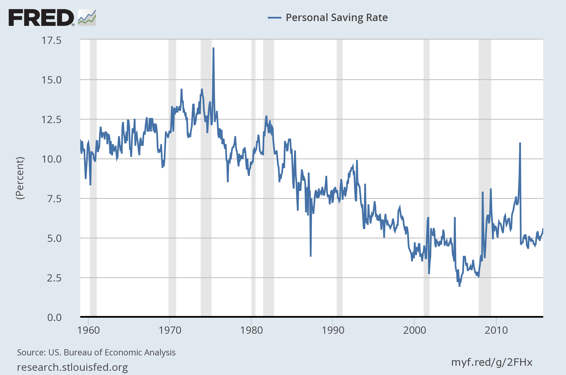 As we move into the holiday shopping season, we find ourselves deluged by catalogs, sales, advertising, and—in my case—impassioned pleas by my seven-year-old son for toys. Spending really doesn’t seem to be a concern, at least in terms of not enough of it.
As we move into the holiday shopping season, we find ourselves deluged by catalogs, sales, advertising, and—in my case—impassioned pleas by my seven-year-old son for toys. Spending really doesn’t seem to be a concern, at least in terms of not enough of it.
From an economic standpoint, though, the economy depends on continued spending growth. Spending growth has actually been quite weak so far in the expansion, and right now there is a fair amount of concern over whether holiday spending will grow by enough this year to keep the economy moving. With incomes growing at a reasonably healthy pace, people can spend. But the problem—if it is a problem—is that people are saving their money, rather than spending it.
Return to “normal”
Much of the commentary has focused on when consumers will return to “normal” savings levels—normal in this case being the sub 5-percent level of the late 2000s—and start to spend. I don’t think they will anytime soon. In fact, I hope they don’t, and looking at the chart below, you can see why.

Low savings spells trouble
Low savings rates have typically been a sign of pending trouble in the years that follow. The savings rate dropped below 5 percent in mid-1987, the late 1990s, and the mid-2000s. Low savings rates have been associated with the end of the boom times, exuberant spending, and a consequent crash.
In fact, even during the bulk of the two prior booms, the 1990s and 2000s, the savings rate was around 6 percent (1990s) and 5 percent (2000s). If you go back a bit further, you see the 1980s boom had savings rates around 8 percent.
The takeaways
I take away two things from this:
- It is perfectly possible to have a healthily growing economy with a savings rate north of 5 percent; in fact, history suggests it is preferable. Higher savings rates are typical of long-lasting growth cycles and, in many ways, essential for them.
- When the savings rate drops precipitously, the end is reasonably near. Given this, the last thing we should be looking for right now are lower savings rates.
What does it mean?
The good news. Continued slow growth in consumer spending is actually something to celebrate as we return to normal. Rather than a sign of weakness, it's a sign of sustainability. That’s the good news.
The other piece of good news is that, with the savings rate most recently at 5.6 percent, we are getting pretty close to levels that prevailed in earlier booms. Once savings stabilizes—and 6 percent is consistent with the past two cycles—then spending can grow faster while consumers continue to save. Just as with wage growth, we may be approaching the end of the corrective cycle.
The bad news. Higher savings rates may not reflect a normalization of savings rates but, instead, more consumer worry. One of the more surprising economic stats has been the decline in consumer confidence in the past couple of months. The rise in savings may be a rational response to that and, if so, may reverse when consumers get more confident.
A good place
These two possibilities are not exclusive, of course, but complement each other well. Regardless of the reason, higher savings means slower but more sustainable growth, as well as reduced systemic risks to consumers as a whole. If the economy speeds up again, higher savings will help to sustain that. If instead the economy slows, higher savings will help cushion the downturn. Either way, this is a good place to be.


 Print
Print


